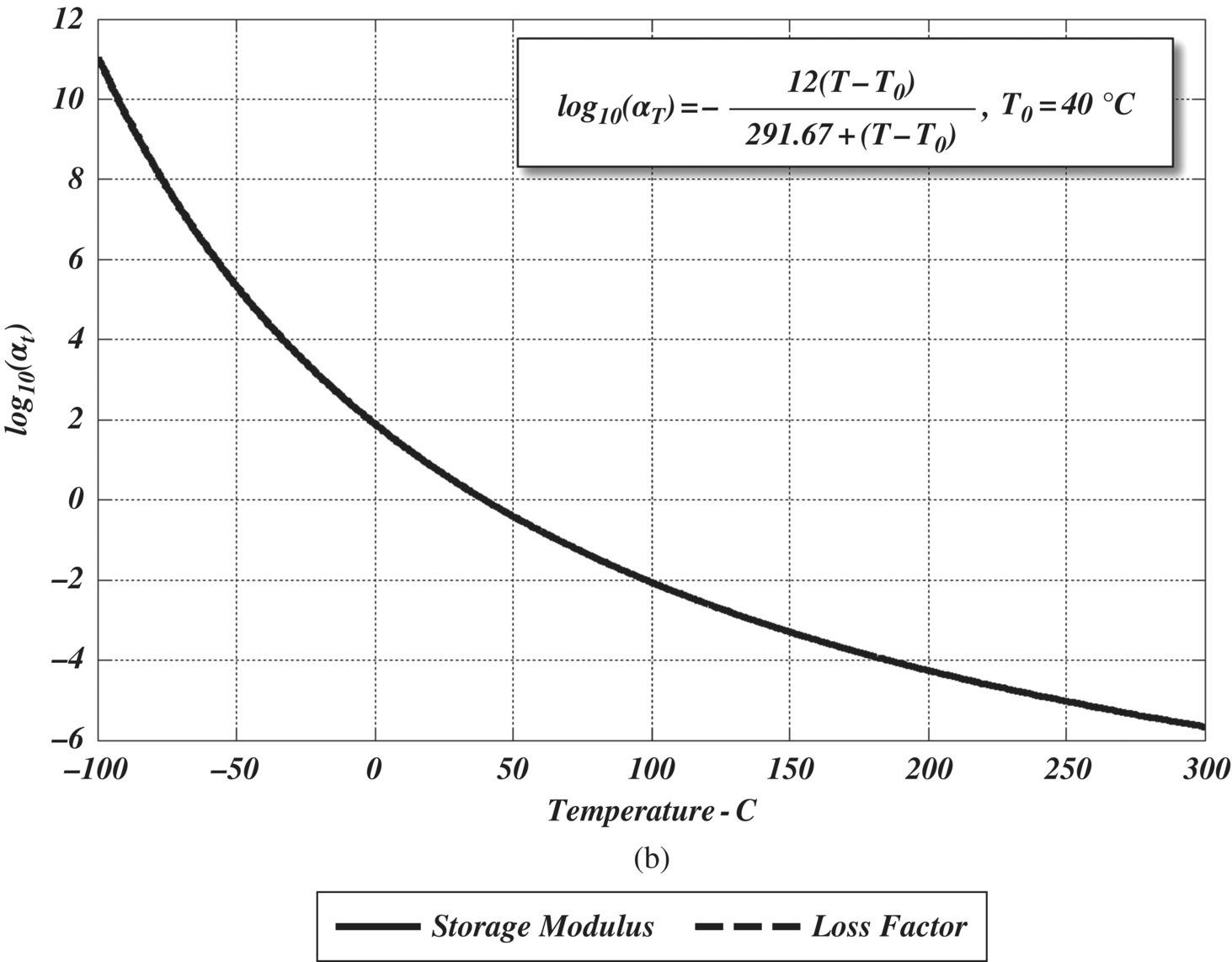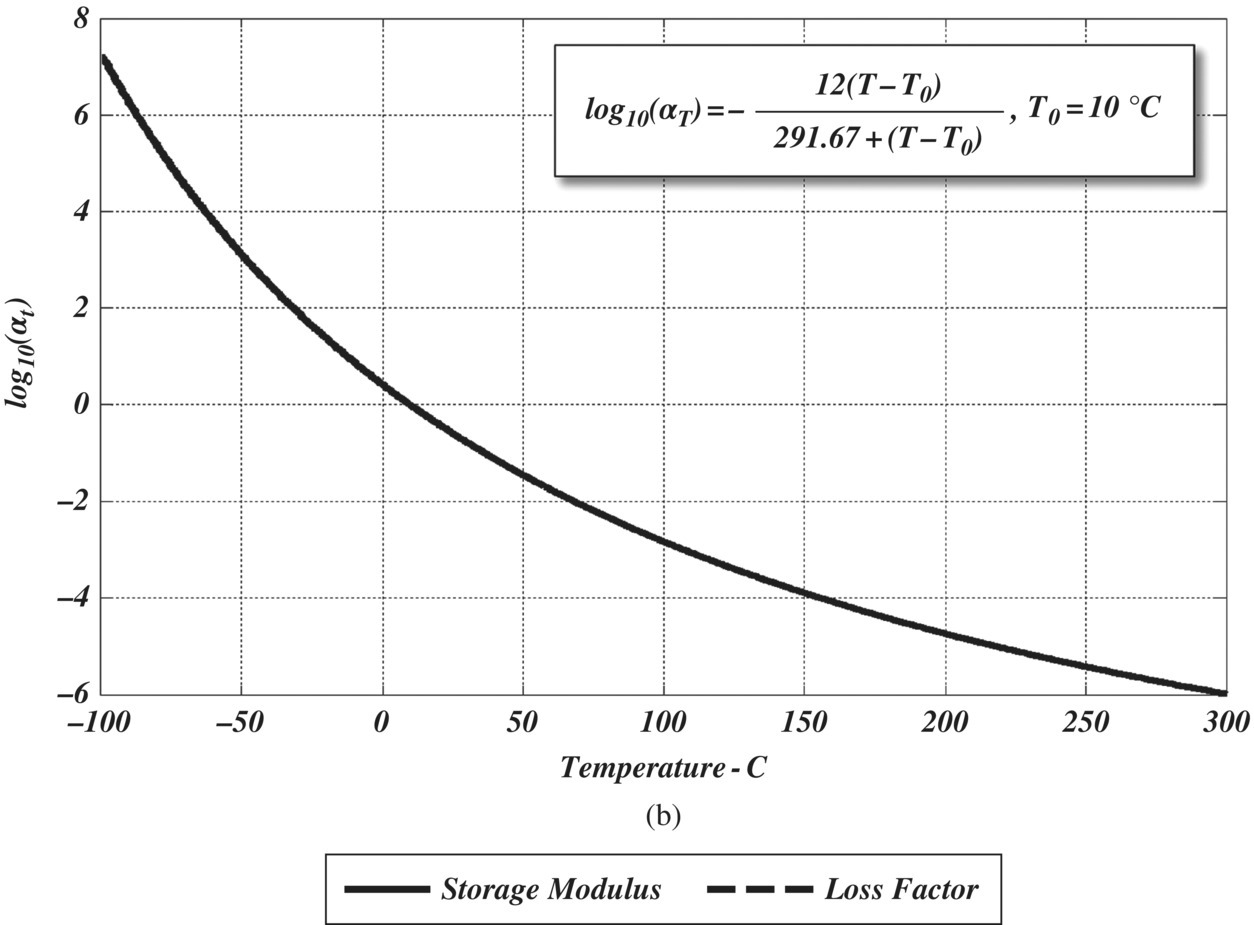Appendix A
Complex Modulus of Typical Damping Treatments
This appendix presents a brief summary of the effect of operating temperature and frequency on the complex modulus of three of the most commonly used viscoelastic materials (VEM). These VEMs are manufactured by 3M (Bonding Systems Division, 3M Center, Building 220‐7E‐01, St. Paul, MN 55144‐1000), E.A.R. (Aearo E.A.R. Specialty Composites, 7911 Zionsville Road Indianapolis, IN 46268), and Soundcoat (Soundcoat, 1 Burt Drive, Deer Park, NY 11729).
A.1 3MTM Viscoelastic Damping Polymers
The main characteristics of the ISD series (110,112, 113) of 3M VEM are summarized in Table A.1 and Figures A.1–A.3.
Table A.1 Operating temperature range, maximum loss factor, and corresponding storage modulus of 3M VEM (ISD 110, 112, 113).
| Polymera,b,c | Operating temperature range (°C) | Maximum loss factor η max at temperature (°C) | Storage shear modulus G ′ at η max (MPa) |
| ISD 110 | 40 to 105 (high) | 1.2 at 55 | 0.12 |
| ISD 112 | −20 to 65 (normal) | 1.1 at 30 | 0.15 |
| ISD 113 | −40 to 20 (low) | 1.2 at −20 | 0.40 |
a 3M, Bonding Systems Division, 3M Center, Building 220‐7E‐01, St. Paul, MN 55144‐1000.
b Poisson's ratio for 110, 112, and 113 viscoelastic damping polymers: approximately 0.49.
c Density for 110, 112, and 113 viscoelastic damping polymers: approximately 0.9–1.0 g cm−3.


Figure A.1 Complex modulus of ISD‐110 (T0 = 70 °C).




Figure A.3 Complex modulus of ISD‐113 (T0 = 10 °C).
A.2 E.A.R. Viscoelastic Damping Polymers
The main characteristics of the C‐1002 and C‐2003 of EAR VEM are summarized in Table A.2 and Figures A.4 and A.5.
Table A.2 Operating temperature range, maximum loss factor, and corresponding storage modulus of E.A.R. VEM (C‐1002, C‐2003).
| Polymera | Operating temperature range (°C) | Maximum loss factor η max at temperature (°C) | Storage shear modulus G ′ at η max (MPa) |
| C‐1002 | 13–41 (low) | 1.02 at 15 | 20.00 |
| C‐2003 | 27–54 (normal) | 1.00 at 45 | 150.00 |
aAearo E.A.R. Specialty Composites, 7911 Zionsville Road Indianapolis, IN 46268.
b Poisson's ratio for EAR viscoelastic damping polymers: approximately 0.49.
c Density for EAR C‐1002, 1105, and 1100 viscoelastic damping polymers: approximately 1.289–1.282 g cm−3.


Figure A.4 Complex modulus of EAR‐C‐1002 (T0 = 140 °C).


Figure A.5 Complex modulus of EAR‐C‐2003 (T0 = 140 °C).
A.3 Soundcoat Viscoelastic Damping Polymers
The main characteristics of the DYAD series (601, 606, 609) of SOUNDCOAT VEM are summarized in Table A.3 and Figures A.6–A.8.
Table A.3 Operating temperature range, maximum loss factor, and corresponding storage modulus of SOUNDCOAT VEM (DYAD – 601, 606, 609).
| Polymera | Operating temperature range (°C) | Maximum loss factor η max at Temperature (°C) | Storage shear modulus G ′ at η max (MPa) |
| DYAD‐601 | −10 to 40 (low) | 1.00 at 20 | 5.00 |
| DYAD‐606 | 10 to 80 (normal) | 1.05 at 40 | 10.00 |
| DYAD‐609 | 0 to 50 (high) | 0.60 at 20 | 20.00 |
aSoundcoat, 1 Burt Drive, Deer Park, NY 11729.
b Poisson's ratio for SOUNDCOAT viscoelastic damping polymers: approximately 0.49.
c Density for DYAD 601, 606, and 609 viscoelastic damping polymers: approximately 1.12–1.3 g cm−1.


Figure A.6 Complex modulus of Dyad 601 (T0 = 40 °C).




Figure A.8 Complex modulus of Dyad 609 (T0 = 70 °C).
Note that all the three types of VEM have comparable loss factors of about 1. But, the 3M ISD series is softer that the E.A.R C‐1002 which is also softer than the SOUNDCOAT DYAD series. However, E.A.R. C‐2003 is the hardest among all the considered VEM treatments. Therefore, for applications that require high damping and medium stiffness, the SOUNDCOAT DYAD series is the most appropriate.
Major Viscoelastic Material Manufacturers Websites
Soundcoat
- Burt Drive, Deer Park, NY 11729
- 1‐800‐394‐8913 or 631‐242‐2200
- Fax: 631‐242‐2246
- www.soundcoat.com/products.htm
E.A.R. Specialty Composites
- 650 Dawson Drive Newark, DE 19713
- Phone (302) 738‐6800 Fax (302) 738‐6811
- www.earsc.com
3M Industrial Business
- Bonding Systems Division
- 3M Center Bldg. 220‐7E‐01
- St. Paul, MN 55144‐1000
- 1‐800‐362‐3550
- www.3m.com/bonding
Roush Anatrol Industries
- 12447 Levan
- Livonia, Michigan 48150
- Main Line: 734‐779‐7006
- Toll‐Free: 1‐800‐215‐9658
- www.roush.com
Damping Technologies, Inc.
- 12970 McKinley Hwy,
- Unit IX
- Mishawaka, IN 46545‐7518
- Tel: 574.258.7916
- www.damping.com
Further Reading
- Adhikari S., Structural Dynamic Analysis with Generalized Damping Models: Analysis, ISTE, Ltd/Wiley: London/Hoboken, NJ, 2014.
- Beards C., Structural Vibration, Analysis and Damping, Butterworth‐Heinemann; 1996.
- Braun S. G., Ewins D. J., and Rao S. S., Encyclopedia of Vibration, Volumes I‐III, Academic Press, 2001.
- Brown, R., and B. Read, Measurement Techniques for Polymers Solids, Elsevier Applied Science Publishers, New York, 1984.
- Chen G. and Zhou J., Vibration and Damping in Distributed Systems, Volume I and II, CRC Press; 1993.
- Christensen R. M., Theory of Viscoelasticity: An Introduction, 2, Academic Press Inc., New York, 1982.
- Drake M. L. and Terborg G. E., Polymeric Material Testing Procedures to Determine Damping Properties and the Results of Selected Commercial Material, Technical Report AFWAL‐TR‐80‐4093, July 1980.
- Drozdov A. D., Mechanics of Viscoelastic Solids, Wiley, 1998.
- Ferry J. D., Viscoelastic Properties of Polymers (3), Wiley, 1980.
- Findley W. N., Lai J. S., and Onaran K., Creep and Relaxation of Nonlinear Viscoelastic Materials, Dover Publications, 1989.
- Flugge W., Viscoelasticity, Blaisdell Publishing Company, Waltham, MA, 1967.
- Garibaldi L. and Onah H. N., Viscoelastic Material Damping Technology, Becchis Osiride, Turin, 1996.
- Haddad Y. M., Viscoelasticity of Engineering Materials, Chapman & Hall, New York, 1995.
- Jones D., Handbook of Viscoelastic Vibration Damping, Wiley; 2001.
- Lakes R., Viscoelastic Solids, CRC Press, Boca Raton, FL, 1999.
- Lakes R., Viscoelastic Materials, Cambridge Press, 2009.
- Mead D., Passive Vibration Control, Wiley; 1999.
- Menard K. P., Dynamic Mechanical Analysis, CRC Press, Boca Raton, FL, 1999.
- Nashif A., Jones D. and Henderson J., Vibration Damping. Wiley, New York, 1985.
- Osinski Z., Damping of Vibrations, Taylor & Francis; 1998.
- Phan‐Thien N., Understanding Viscoelasticity: Basics of Rheology, Springer Verlag, 2002.
- Rivin E. I., Stiffness and Damping in Mechanical Design, Marcel Dekker; 1999.
- Rivin E. I., Passive Vibration Isolation, American Society of Mechanical Engineers; 2003.
- Sun C. and Lu Y. P., Vibration Damping of Structural Elements, Prentice Hall, Englewood Cliffs, NJ, 1995.
- Tschoegl N. W., The Phenomenological Theory of Linear Viscoelastic Behavior: An Introduction, Springer Verlag, 1989.
- Wineman A. S. and Rajagopal K. R., Mechanical Response of Polymers: An Introduction, Cambridge University Press, 2000.
- Zener C. M., Elasticity and Anelasticity of Metals, University of Chicago Press, Chicago, 1948.
